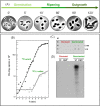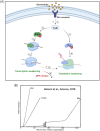Reviving the view: evidence that macromolecule synthesis fuels bacterial spore germination
- PMID: 37223344
- PMCID: PMC10117790
- DOI: 10.1093/femsml/uqac004
Reviving the view: evidence that macromolecule synthesis fuels bacterial spore germination
Abstract
The Gram positive bacterium Bacillus subtilis and its relatives are capable of forming a durable dormant long-lasting spore. Although spores can remain dormant for years, they possess the remarkable capacity to rapidly resume life and convert into actively growing cells. This cellular transition initiates with a most enigmatic irreversible event, termed germination, lasting only for a few minutes. Germination is typified by a morphological conversion that culminates in loss of spore resilient properties. Yet, the molecular events occurring during this brief critical phase are largely unknown. The current widely accepted view considers germination to occur without the need for any macromolecule synthesis; however, accumulating data from our laboratory and others, highlighted here, provide evidence that both transcription and translation occur during germination and are required for its execution. We further underline numerous overlooked studies, conducted mainly during the 1960s-1970s, reinforcing this notion. We propose to revisit the fascinating process of spore germination and redefine it as a pathway involving macromolecule synthesis. We expect our perspective to shed new light on the awakening process of a variety of spore-forming environmental, commensal, and pathogenic bacteria and possibly be applicable to additional organisms displaying a quiescent life form.
Keywords: Bacillus subtilis; spore dormancy; spore germination; spore revival; sporulation.
© The Author(s) 2022. Published by Oxford University Press on behalf of FEMS.
Conflict of interest statement
None declared.
Figures


Similar articles
-
The molecular timeline of a reviving bacterial spore.Mol Cell. 2015 Feb 19;57(4):695-707. doi: 10.1016/j.molcel.2014.12.019. Epub 2015 Feb 5. Mol Cell. 2015. PMID: 25661487 Free PMC article.
-
Investigating Synthesis of the MalS Malic Enzyme during Bacillus subtilis Spore Germination and Outgrowth and the Influence of Spore Maturation and Sporulation Conditions.mSphere. 2020 Aug 5;5(4):e00464-20. doi: 10.1128/mSphere.00464-20. mSphere. 2020. PMID: 32759333 Free PMC article.
-
Integrative Analysis of Proteome and Transcriptome Dynamics during Bacillus subtilis Spore Revival.mSphere. 2020 Aug 5;5(4):e00463-20. doi: 10.1128/mSphere.00463-20. mSphere. 2020. PMID: 32759332 Free PMC article.
-
Clostridium difficile spore biology: sporulation, germination, and spore structural proteins.Trends Microbiol. 2014 Jul;22(7):406-16. doi: 10.1016/j.tim.2014.04.003. Epub 2014 May 7. Trends Microbiol. 2014. PMID: 24814671 Free PMC article. Review.
-
Bacillus spore germination at moderate high pressure: A review on underlying mechanisms, influencing factors, and its comparison with nutrient germination.Compr Rev Food Sci Food Saf. 2021 Jul;20(4):4159-4181. doi: 10.1111/1541-4337.12789. Epub 2021 Jun 19. Compr Rev Food Sci Food Saf. 2021. PMID: 34147040 Review.
Cited by
-
Glutamate catabolism during sporulation determines the success of the future spore germination.iScience. 2022 Oct 2;25(10):105242. doi: 10.1016/j.isci.2022.105242. eCollection 2022 Oct 21. iScience. 2022. PMID: 36274945 Free PMC article.
-
Newly identified SpoVAF/FigP complex: the role in Bacillus subtilis spore germination at moderate high pressure and influencing factors.Appl Environ Microbiol. 2025 Feb 19;91(2):e0204724. doi: 10.1128/aem.02047-24. Epub 2025 Jan 21. Appl Environ Microbiol. 2025. PMID: 39835809 Free PMC article.
-
Processing of stalled replication forks in Bacillus subtilis.FEMS Microbiol Rev. 2024 Jan 12;48(1):fuad065. doi: 10.1093/femsre/fuad065. FEMS Microbiol Rev. 2024. PMID: 38052445 Free PMC article. Review.
-
The DeoR-like pleiotropic regulator SCO1897 controls specialised metabolism, sporulation, spore germination, and phosphorus accumulation in Streptomyces coelicolor.Commun Biol. 2024 Nov 7;7(1):1457. doi: 10.1038/s42003-024-07164-8. Commun Biol. 2024. PMID: 39511385 Free PMC article.
-
Recent progress in proteins regulating the germination of Bacillus subtilis spores.J Bacteriol. 2025 Feb 20;207(2):e0028524. doi: 10.1128/jb.00285-24. Epub 2025 Jan 8. J Bacteriol. 2025. PMID: 39772627 Free PMC article. Review.
References
-
- Balassa G, Contesse G. [Macromolecular synthesis during the germination of spores of B. subtilis. I. Kinetics]. Ann Inst Pasteur (Paris). 1965;109:683–705. - PubMed
Publication types
LinkOut - more resources
Full Text Sources
